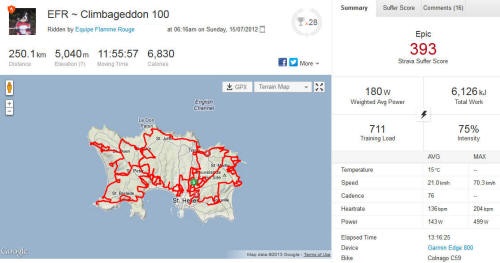Energy Expenditure
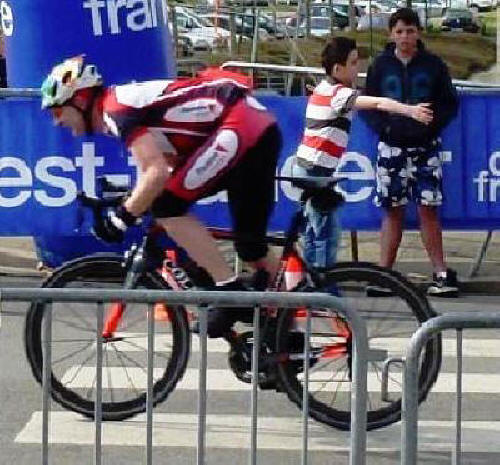
you can only get out what you put in
This factsheet was inspired by the many questions I've had on the "confusing" issue of readouts on heart monitors, bike computers, power meters, power software and now, even programmes like Strava and Garmin Connect. Everyone, it seems, is starting to display ride information relating to watts, kilojoules and Calories.
Here I'll try to explain what these entities are, to what they relate and how you can use the information provided to improve your training, your expectations, performance, results and recovery.
It may appear a little heavy at first, but this factsheet could give you the impetus you need to make or break one of your seasons key objectives. Stick with it to the end and hopefully it will all fall in to place.
Watt's a kilojoule?
See what I did there? Well a kilojoule (kj) is a
measure of energy expenditure or work performed. Calories
are falling out of favour and kilojoules are the measurement of choice
in the new millennium.
A joule is defined as being the energy expended when one kilogram, is moved one metre, by a force of one Newton.
Wouldn't know a Newton if I fell over one, I'm still trying to get used to kilograms! Anyway, a Newton is what it is. When you press on the pedals, the "heaviness" of the press is measured in Newtons. Used to be foot-pounds, but now it's Newtons.
If you've been with us since our first posts in 2003 you will know that a watt is basically the calculation of work done divided by time. One watt equals approximately a thousandth of a horsepower and one watt is also equal to one joule of work per second of time.
There we have it! A direct correlation between joules and watts.
Without getting in to too much detail (he says ironically) there are approximately 4.2 joules in a calorie.
A joule and a calorie are very small units of measurement. So, to make things more useable we measure in kilojoules and kilocalories. To simplify (or complicate) matters further we almost always refer to kilocalories as Calories with a large "C". When you see Calories spelt this way we are referring to a thousand calories. One kilocalorie equals one Calorie.
Just a little more science and we're there. Extrapolating our formula from above, there are 4.2kj in a Calorie. When you return from your ride and you download your data you may get a reading reporting the work that you've done in kilojoules or Calories depending on the manufacturers prevalence. At least you now have the information to relate them to each other.
Work
Done, Energy Out, Energy In?
That's all the theory out of the way, let's look at some
practical stuff.
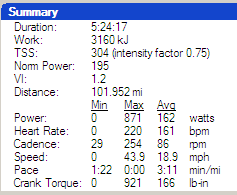 During an edition of the
Cyclo Danguillaume,
I cracked out 3160kj of work, as you can see from the WKO+ power
summary on the right.
During an edition of the
Cyclo Danguillaume,
I cracked out 3160kj of work, as you can see from the WKO+ power
summary on the right.
It was 102 extremely hilly miles, covered in a little over five hours, at 19 mph (164 kms @ 30.7 kph); the duration time in the summary includes riding to and from the start/finish.
Normalised power output was 195 watts with a peak of 871 watts.
So how does this information help me become a better rider, train better and improve my future performances? All of it can, and we'll cover the other parameters in later factsheets, for now we'll concentrate solely on the kilojoules element and what it gives us.
We know there were 3160 kilojoules expended during the ride. It would normally be safe to assume, that using the formulae and information above, you would just divide the kilojoules (3160kj) by 4 to arrive at a Calorie count. Then divide that by five hours to work out how much food you need to eat, per hour, to fuel a ride of this nature.
As ever life, especially cycling life, isn't that simple.
Mechanical Efficiency
We all learnt at a very early age,
well you did when I was at school, that perpetual motion is impossible.
You can't get something for nothing.
From my days at engineering college, and later from my time in motor racing, I learnt all about thermodynamics, frictional losses and mechanical efficiency. Which at first appears to have nothing to do with cycling. But the dots do join up!
Machine efficiency is very much different to human efficiency. just to set some context, I'll give you a practical, condensed version.
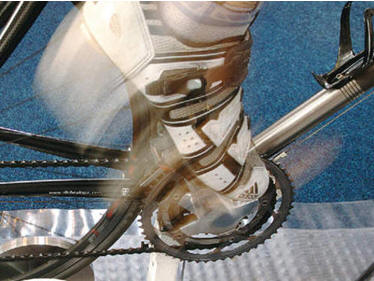
Bicycles are extremely efficient. Almost 97% of the energy you put in to the pedals gets to the ground, via the chain and wheels, to propel you and your machine of choice forward.
Frictional losses occur in the pedal and bottom bracket bearings, the chain, the freehub, the wheel bearings and the tyres gripping the road. For now we'll ignore aerodynamics. But for our purposes almost everything we put in to the bike at the pedals, we get out at the wheels.
Work, no matter what its type, generates heat and heat burns energy. That's why we sweat when we exercise. Heat, unless you're specifically producing it to keep warm, is a by product of energy production.
Heat is energy that's not being directed to propelling you forward. Heat is natures way of telling you your working hard. Even though it's energy being effectively wasted it still has to be accounted for and replaced.
Humans are somewhat different to machines. We are very, very, very inefficient. At best our efficiency is around 25%.
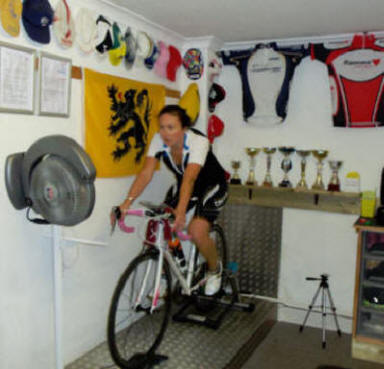
Anyone who's been for one of our wVo2max tests will tell you how unbelievably hot they get in six minutes. When you're pushing out 250w in a test you will generate three times that in heat.
250 watts powering the bike, plus the 750 being wasted as heat, equals the equivalent output of a 1 bar electric fire. That takes some dissipating on a turbo!
Knowing what we know about human efficiency, we can relate this to our work calculations, energy expenditure and calorific intake.
Our 25% mechanical efficiency equals a 4 to 1 energy input/output ratio. This means we need to consume four times the amount of energy we are expecting to put out, or, to put it another way for every four Calories we consume we can only use one as fuel.
As I explained earlier 4.2kj equal a Calorie. Using the information in the paragraph above, we need to consume 4 Calories to produce just under one kilojoule of work. For our purposes 4.2 is close enough to 4 to equal a like for like comparison. We can now use these snippets of info to our advantage when preparing an energy replacement strategy.
How does
this help you?
To recap, although the ratio of kilojoules to Calories isn't exactly
one-to-one we can assume, for the purpose of our needs, that it is.
The difference is not worth worrying about in the big scheme of things.
So, in effect you need to provide one Calorie of energy to replace each kilojoule of work done. This means 1000 kilojoules of work done requires 1000 Calories of energy to fuel it.

Fuelling
Strategy
Using my example above, you can
see my work done equated to 3160kj, which we can "convert" to
require approximately
3000 Calories of fuel to drive it. It's science but we don't need to be exact
we're riding a bike not sending a man to the moon.
If you've properly prepared for your event, the glycogen levels in your muscles and liver (the fuel tank) will be fully stocked. The body can store around 350 grams of glycogen which will give you enough energy for around 90 minutes of hectic activity.
So in effect we've got 90 minutes of energy, or (my approximation) 900 Calories, in the bank.
For endurance events, it's important that you keep yourself topped up with fuel, and begin to replenish it before stocks run low.!
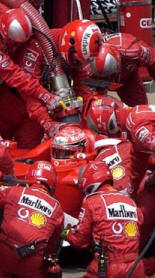 A
Formula One car doesn't need to finish a Grand Prix with full fuel tanks.
And
we don't normally need to finish an event with fully stocked glycogen
levels. The key word there is "normally", which I'll come back
to later.
A
Formula One car doesn't need to finish a Grand Prix with full fuel tanks.
And
we don't normally need to finish an event with fully stocked glycogen
levels. The key word there is "normally", which I'll come back
to later.
If we endeavour to keep our finishing reserves moderately stocked, we can pull 600 Calories from our equation to finish with our "tanks" a third full.
So 3000 required, minus 600 we don't have to replenish means we need 2400 Calories to fuel us to the end of our event.
2400, divided by the 5 hours it took me to complete the event, requires a fuelling strategy of at least 480 Calories/hour.
The more enlightened of you will have something in your bottles that's stronger than water and more sophisticated than diluted Ribena, even if it is the "tooth-kind" variety.
Stocking up with two, 750 ml bottles of something like TORQ, Viper or CNP, will give you 200 Calories per bottle.
Which means, we should be looking to consume around another 200+ Calories an hour on the bike for optimal performance to be maintained.
This can be done with power bars, gels, dried fruits or just good old solid food. I'm not going to dive in to the complexities of glycemic indexes and fast & slow foods here, but you should consider your options. Especially in shorter or ultra long events.
Things you need to know
The body can only absorb 1 gram (4.1 Calories) of carbohydrate a minute.
To process each gram of carbs we consume we need to drink 3 grams of
water. So when you eat, you drink, and you do everything in
moderation.
Don't wait for an hour then eat a 100 gram energy bar and down a pint of water to help it on it's way! Little and often is the cliché for the day. Ten grams of carbs every ten minutes, is ten times better than a 60 grams every hour.
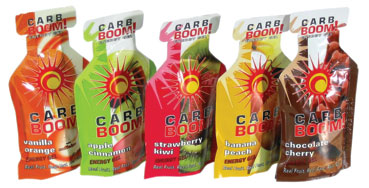
As stated above, one gram of carbs supplies 4 Calories of energy. So do your sums, work out how long you think your event might last and work out how much and how often you need to eat.
Don't prepare all year for a big event and let your excitement cloud your judgement on the details that matter. It's the small things that make a huge difference.
For events lasting an hour or less you will not even need to eat. You can get by with just an energy drink for hydration purposes rather than fuel. Remember 6% carb solutions will be absorbed through the intestine quicker than plain water.
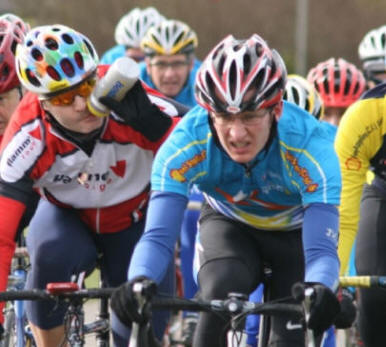
For events over an hour you will need to fuel your tanks. If you ride at below threshold and have the correct nutritional strategy you can, in effect, ride all day. How do you think the 24 Hour time triallists manage?
Don't follow the Pro's
When you see Tour de France riders throwing food down their throat in
the last 20k of a stage they're not eating for today, they're eating for
tomorrow.
They need to get glycogen in to their muscles during the twenty minute post exercise glycogen window. The best way to do that is to eat before you finish. Once you stop, the digestion process is well under way and filling the tanks. Unless you're in a stage race, or multi-day event, you don't need to, so don't try it. You'll only be sick come the sprint.
Final Note
Without going too overboard we must remember that these are figures to
replace energy for sporting needs. We have our own Basal Metabolic
Rate (BMR), which is the amount of energy we need to consume just to
support our body's normal life support functions.
BMR is used to provide diet information for bed ridden hospital patients. If we did nothing but stay in bed all day a 1.8 metre, male of 70 kilos, would "consume" 1760 Calories. So you need this as a minimum to stay in balance.
Then there are lifestyle calories to be included are you a sedentary office worker or do you work down a salt mine (another job I've had in the past). One would obviously have a larger energy requirement than the other. And it's not the office worker! During a five hour event your body functions "naturally consume" 750 Calories.
There's no need to become obsessive about this, but if you find yourself coming up short in your training, or test events, these are issues to bear in mind.
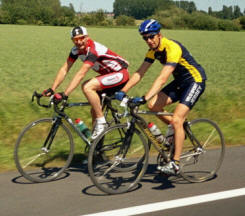 The Message
The Message
In the
event on the right, Dave Whitt (pictured), Steve Goziou and myself competed in the
super tough Paris Roubaix Sportive.
During which Dave's Polar heart monitor clocked an energy expenditure of 5600 Calories.
Which, minus the 600 we didn't need to replace, for the seven and a half hours we rode, works out at 666 Calories per hour.
Which for a race dubbed the Hell of the North is quite appropriate.
Dave's count was a little higher than mine because his was "computed" from heart rate, speed, distance and time algorithm's against a pre-determined "average burn rate" formula that Polar use.
Mine was taken from my SRM which is taken directly from the power output of the cranks. Remember from the formulae above, one watt equals one joule per second and one kilojoule equals one Calorie
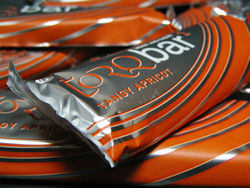
Whatever process, formula or system used, we now have anecdotal and empirical evidence to prove that we all need to consume big Calories, and drink well, on big rides. You heard it here first!
At each of the five feed checkpoint stations, we stocked up with food and took on three pints of fluids.
That's fifteen pints of drink, plus the three we started with.
We finished with empty pockets, empty bottles and empty stomachs. But we finished and we finished well.
Eat little, eat often and mix your food between high and low glycemic index types to give an immediate and sustained burn.
Drink more than you think you need and eat, eat, eat. Aim to consume at least 400 Calories an hour, around 200 of which should be coming from your drinks bottle.
The longer your event the closer to this figure you need to be. I know it seams a lot but remember, for every 400 you eat only 100 gets to the muscles.
I know I've said it a thousand times but I'll say it again. Don't try this, or anything else (including food types), for the first time on the day of your event. Try a few dry runs during your preparation phase.
Happy endurance riding.
